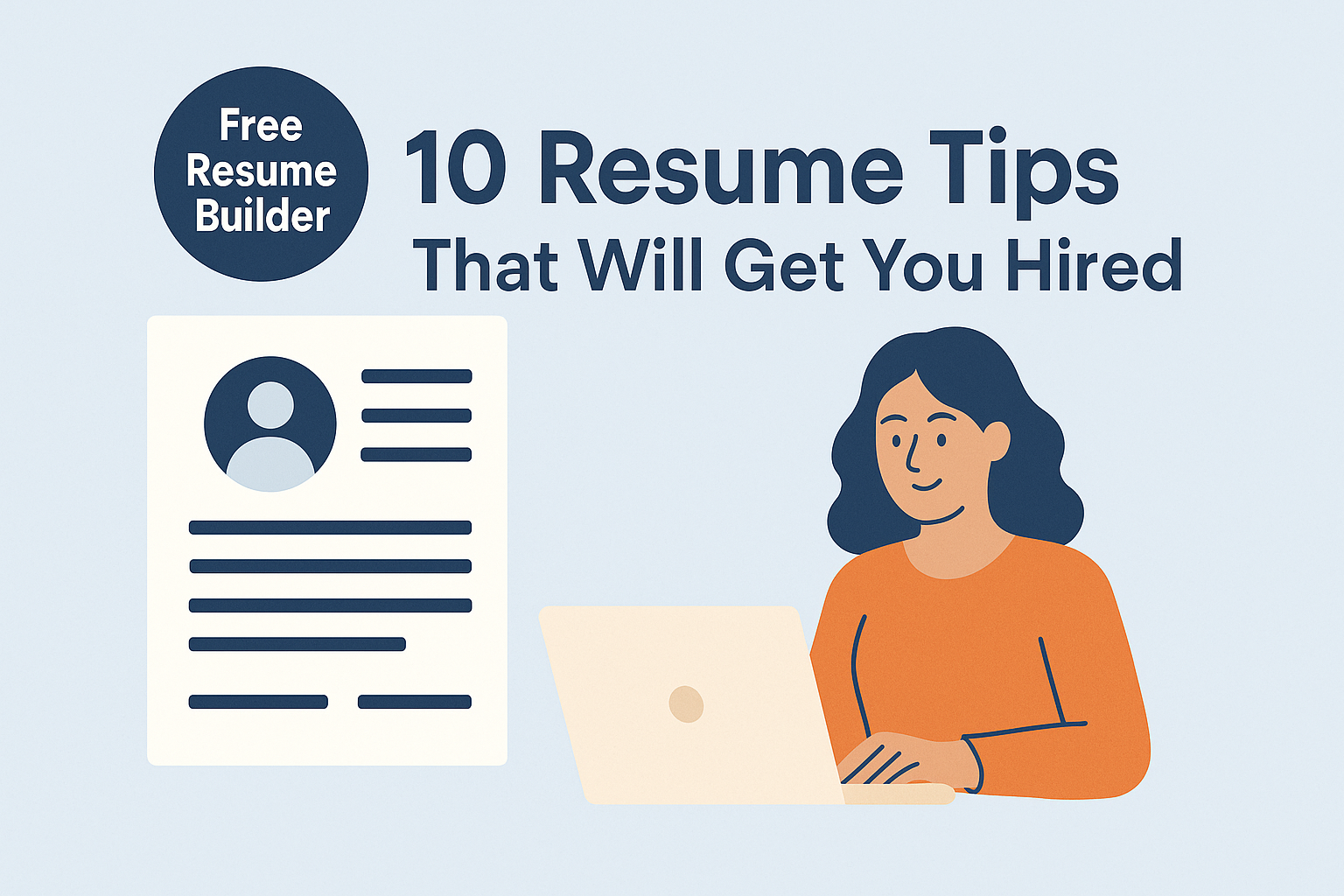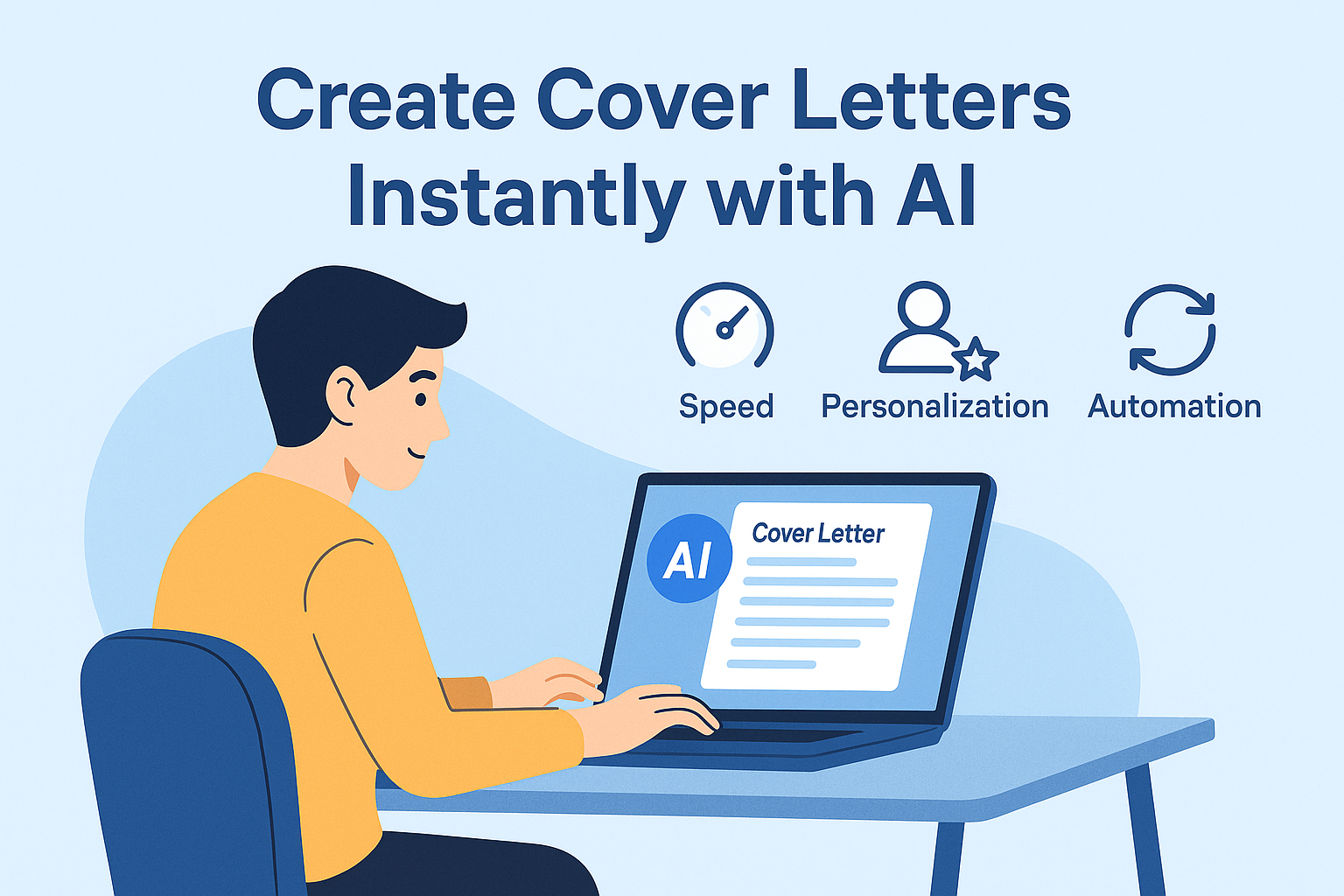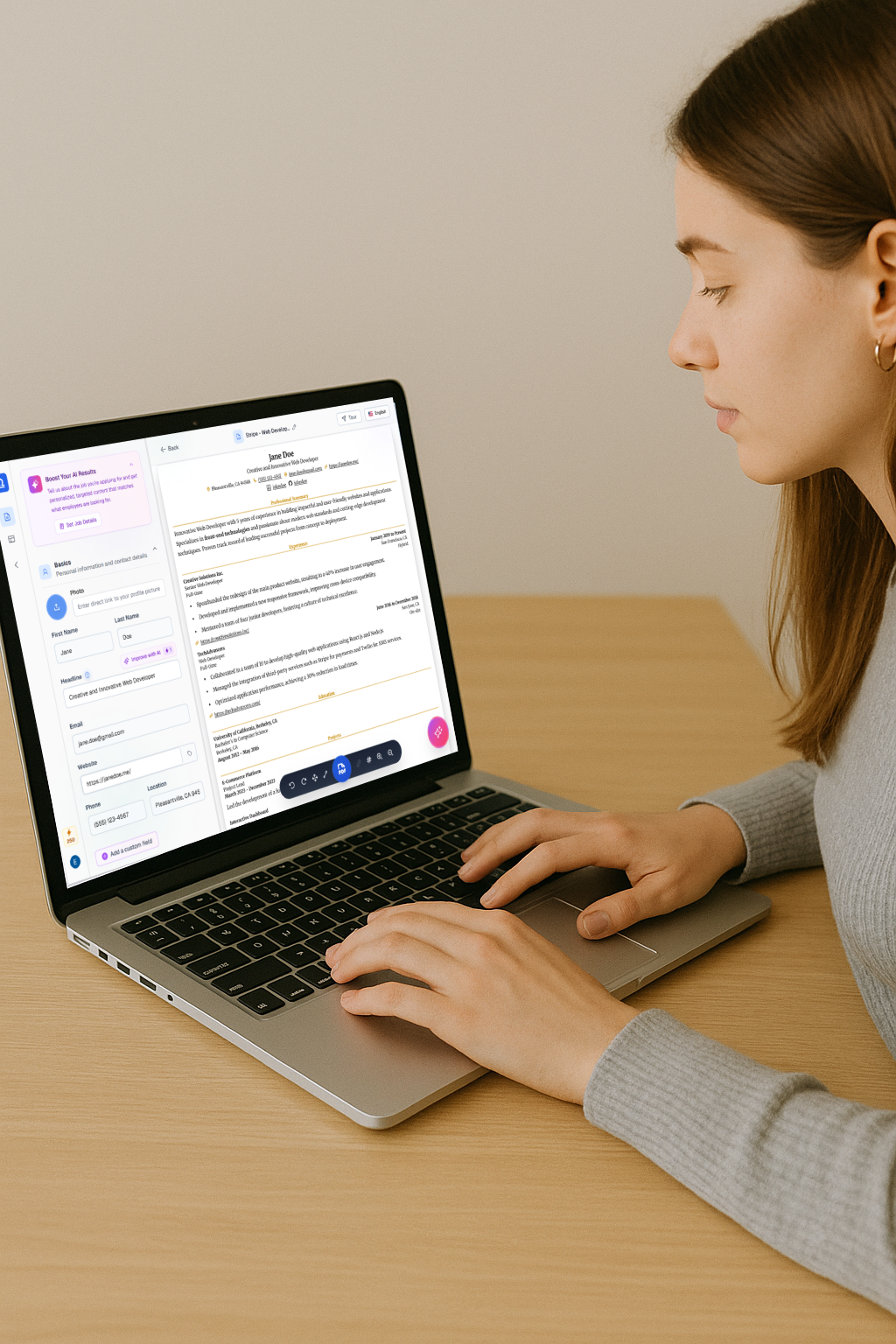
How to Write a Resume With No Experience (Step-by-Step Guide)
Learn how to write a resume with no experience. Step-by-step guide with examples for students, recent grads, and first-time job seekers.
Ethan Parker
Author
Introduction
Writing your first resume can feel intimidating - especially when you don’t have formal work experience to list. But here’s the truth: no experience doesn’t mean no value. You’ve gained skills through school projects, volunteering, part-time jobs, hobbies, and personal initiatives - and those can make a strong impression when presented the right way.
In this guide, you’ll learn how to write a resume with no experience that still looks polished and professional. We’ll cover everything from choosing the right structure to writing each section step-by-step, complete with examples for students, recent graduates, and career changers. You’ll also discover how to showcase your potential through projects, portfolios, and a strong online presence.
Whether you’re figuring out how to write a resume for your first job or wondering how to write a resume without work experience, you’ll find clear answers and practical advice here. Tools like Democruit can even help you format, edit, and polish your resume effortlessly - so you can focus on telling your story, not fighting with templates.
Now, before you start writing, let’s explore how Applicant Tracking Systems (ATS) read resumes and why your format matters more than you think.
Before You Start: Key Things to Know
Before you start crafting your resume, it’s important to understand how resumes are actually screened today - and why structure and formatting matter just as much as your content. Most employers use Applicant Tracking Systems (ATS) to sort, scan, and rank resumes before a human ever sees them. These systems look for keywords, job titles, and relevant skills that match the job description. If your resume isn’t ATS-friendly, it might never reach the recruiter’s hands - no matter how talented you are.
So, what does that mean for you? Keep your design simple and readable. Avoid fancy graphics, text boxes, or columns that could confuse ATS software. Stick to standard section titles like Education, Skills, and Projects, and use clear formatting. In today’s competitive job market, clarity and relevance beat style every time. A clean, well-organized document shows professionalism - even if you’re still figuring out how to write a resume with no experience.
Next, let’s talk about choosing the right resume format. There are three main types:
- Chronological: Lists work experience in order - best if you have steady job history.
- Functional (skills-based): Focuses on abilities and achievements rather than job titles - perfect if you’re writing your first resume or switching careers.
- Combination: Blends both - highlights skills first, then relevant experience or education.
For students, recent grads, or career changers, a functional or combination format usually works best. These formats put your strengths - not your gaps - in the spotlight.
If you’re using a builder like Democruit, you can easily select an ATS-optimized layout that fits your situation. Once you’ve got your format and foundation in place, you’re ready to dive into the next part - understanding why your resume still matters, even without formal work history.

Why the Resume Still Matters (Even Without Work History)
Even if you’ve never had a formal job, your resume still plays a powerful role - it’s your personal marketing tool. Employers don’t just hire based on work history; they hire based on potential, attitude, and transferable skills. When recruiters look at a resume with little experience, they’re asking: “Can this person learn quickly, take initiative, and contribute to our team?” If you can show evidence of that through school projects, volunteering, internships, or personal initiatives, you’re already ahead.
This is especially true for students, recent graduates, and career changers. If you’re a student or just starting out, your education and extracurriculars show dedication and curiosity. If you’re changing careers, your previous roles likely taught you communication, problem-solving, or leadership - skills that carry over. And if you’re returning to work after a break, your volunteer work or community involvement can demonstrate reliability and drive.
The key mindset shift is this: focus on what you can offer, not what’s missing. A resume isn’t just a record of jobs - it’s a story of growth and capability. Use it to show who you are, what you’ve learned, and how you’re ready to contribute.
In the next section, we’ll break down exactly how to write each part of your resume - from your header and objective to your skills, projects, and beyond - with examples you can adapt right away.
Step-by-Step Guide to Writing Each Resume Section (With Examples & Pro Tips)
Now that you know your resume still matters - even without work experience - it’s time to build it step by step. Each section plays a specific role in showing who you are, what you can do, and where you’re headed. Follow these guidelines to create a resume that looks professional and feels authentic, even if you’re writing it for your first job.
1. Header (Mandatory)
Your header is the first thing a recruiter or ATS reads, so keep it clear, professional, and easy to scan. Include your full name, email, phone number, and LinkedIn profile. Include a brief target role under your name - for example, “Aspiring Data Analyst” or “Entry-Level Marketing Assistant.” It helps both recruiters and ATS tools quickly understand your career focus. If you have a portfolio, GitHub, or personal website, add those links too - they showcase your initiative and skills beyond your resume.
What to include:
- Full name
- Target role (e.g. Aspiring Data Analyst | Python & Excel Enthusiast)
- Email (professional, not funnyname92@gmail.com)
- Phone number (with country code if applying internationally)
- City + State (no full address)
- LinkedIn profile or portfolio link (optional but recommended)
Weak Example:
John D.
Recent Graduate johnnycool1998@yahoo.com
Improved Example:
John Davis
Aspiring Data Analyst | Python & Excel Enthusiast
(555) 123-4567 | john.davis@gmail.com
linkedin.com/in/johndavis | portfolio.johndavis.dev
Pro Tip: Skip your photo unless you’re applying in a region or industry where it’s standard. Keep links clickable and professional.
2. Career Objective or Summary (Mandatory)
When you don’t have formal experience, a career objective is your chance to show intent, enthusiasm, and alignment with the role. Write 2-3 sentences that describe who you are, what you’re aiming for, and what value you bring. Avoid generic statements like “Looking for an opportunity to learn and grow.” Instead, be specific.
Weak Example:
I’m a recent graduate seeking any job opportunity to gain experience.
Improved Example:
Motivated Computer Science graduate with strong problem-solving skills and hands-on experience building web apps in React. Eager to contribute to a growth-oriented tech team while continuing to learn.
Pro Tip: Tailor this section to each role. Mention specific skills or goals that align with the company’s needs - that’s how you stand out when learning how to write a resume with no experience.
3. Education (Mandatory)
For students and first-time job seekers, education is one of your strongest assets. List your degree, major, university name, and graduation year (or “expected” date). Include relevant coursework, academic projects, or honors that align with your target role. If your GPA is strong (3.5/4.0 or higher), include it; otherwise, you can leave it out.
Weak Example:
B.A. in Psychology, 2024 - University of Chicago
Improved Example:
B.A. in Psychology, University of Chicago (Expected 2024) Relevant Coursework: Behavioral Research Methods, Data Analysis, Cognitive Science GPA: 3.8/4.0 | Dean’s List (2022-2024)
💡Pro Tip: If you’re still in school or just graduated, place this section near the top of your resume.
4. Skills (Mandatory)
This section gives hiring managers a quick view of your strengths. It shows what you can do, not just what you’ve done. Focus on transferable skills (communication, teamwork, problem-solving) and technical or industry-specific skills (Excel, Python, Adobe Creative Suite, CRM tools). Use short bullet points and group them if possible (e.g., “Technical Skills,” “Soft Skills”).
Weak Example:
Communication, leadership, computers
Improved Example:
Technical Skills: Python, SQL, Google Sheets, Tableau Soft Skills: Problem-solving, time management, collaboration
Pro Tip: Read the job description and match your skills to the employer’s needs - this improves your ATS score and shows fit.
5. Projects (Highly Recommended)
Projects are your best proof of ability - especially when you don’t have work experience. Include academic, personal, or volunteer projects that demonstrate initiative or relevant skills. Use 2-3 results-focused bullet points per project, following the formula: Action + Task + Result.
Weak Example:
School project about website design
Improved Example:
Portfolio Website - Designed and built a personal website using HTML, CSS, and JavaScript to showcase projects and blogs. Increased traffic by 40% through SEO optimization.
Pro Tip: Include results or measurable impact whenever possible - it shows initiative and real-world ability. Tools like Democruit can help you structure and describe your projects effectively.
6. Relevant Experience (Optional but Powerful)
Even if you’ve never had a “real” job, you’ve likely done something relevant - internships, part-time roles, volunteer work, student leadership, or freelance gigs all count.
Describe them like professional experience: use bullet points that start with action verbs (organized, designed, supported, led). Focus on impact and transferable skills, not job titles.
Weak Example
Worked at the campus café.
Improved Example:
Barista, Campus Café, University of Oregon (2023-Present) Delivered friendly service to 100+ students daily and trained 2 new staff members. Improved efficiency by reorganizing workflow during rush hours.
💡Pro Tip: Use action verbs (“organized,” “led,” “created,” “improved”) and focus on achievements, not duties. Don’t underestimate soft skills learned in non-professional roles - teamwork, reliability, and customer interaction all matter.
7. Certifications (Optional)
Certifications show initiative and continued learning, a great advantage for students or first-time job seekers. They are a quick credibility boost - especially when you lack formal experience. Include industry-relevant or skills-based credentials, such as Google Analytics, HubSpot, LinkedIn Learning, or Coursera courses. Even free online credentials can add value if they relate to your target role. List them with the certification name, issuing organization, and completion year:
Weak Example:
Completed online course in Excel
Improved Example:
Microsoft Excel Associate Certification, Microsoft Learn, 2024
💡Pro Tip: Choose certifications that align with your target job. A marketing student, for instance, could include Google Ads or Meta Blueprint certifications.
8. Awards & Honors (Optional)
Awards add credibility and highlight your commitment to excellence. They show achievement, recognition, and motivation - qualities employers love. Include scholarships, dean’s list honors, competition placements, or leadership awards. Keep it short and relevant:
Weak Example:
Won school award
Improved Example:
Dean’s Leadership Award (2023): Recognized for organizing peer mentorship sessions that supported 50+ new students.
💡Pro Tip: If you don’t have formal awards, consider achievements like scholarships, competition wins, or club leadership.
9. Languages (Optional)
Purpose: Languages are often overlooked, but they can differentiate you - especially for global companies or diverse teams. List any language you can confidently communicate in, along with your proficiency level.
Weak Example:
English, Spanish
Improved Example:
Languages: English (Native), Spanish (Intermediate - B1 Level)
💡Pro Tip: List proficiency levels honestly and use recognized scales (Beginner, Intermediate, Fluent, Native).
Final Thoughts
Writing your first resume doesn’t have to feel overwhelming. Each section builds a clear, confident picture of who you are and what you bring. Start small - fill in what you have now, then refine and improve as you grow.
Next, we’ll explore how to turn your projects and coursework into a consistent portfolio, even if you’ve never had a job, so your resume comes to life visually and professionally.
Create a Consistent Portfolio (Even Without a Job)
Even if you’ve never had a formal job, you can still prove your skills with a portfolio. Think of it as your personal evidence - a place where you turn projects, coursework, or hobbies into visual proof of what you can do. Your portfolio doesn’t need to be fancy or packed with experience. Start simple:
- Projects: Upload your school or personal projects to GitHub, Behance, or Notion.
- Coursework: Showcase assignments or research that reflect your strengths - like data visualizations, essays, or app prototypes.
- Hobbies: Even personal interests, like designing graphics for a club or building a small app, can demonstrate initiative and creativity.
Make sure your portfolio aligns with your resume. If your resume lists a Python project, link directly to the GitHub repository. If you mention design skills, include a few visuals or mockups. Consistency builds trust - employers love seeing proof that matches your claims.
You can create a simple, one-page PDF portfolio or host your work online using free tools. Platforms like Democruit make it easy to connect your resume and portfolio, keeping your presentation cohesive and professional.
💡Pro Tip: Focus on quality over quantity. Two or three well-documented projects that clearly show your skills will make a stronger impression than ten unfinished ones.
Build a Professional Online Presence
Your resume may open the door, but your online presence helps employers decide whether to walk through it. In today’s job market, recruiters often check your LinkedIn or portfolio before reaching out - so building a professional, consistent online profile is essential, even if you have no formal work experience.
LinkedIn: Your Digital Resume
If you’re wondering how to write a resume with no experience, LinkedIn is your best friend. It’s where you can expand on your story beyond one page. Applicants with a completed LinkedIn profile are 71% more likely to receive a callback than those without one (source).
- Write a headline that shows your goal and specialty - for example, “Aspiring UX Designer | Skilled in Figma & User Research.”
- Add a short About section that summarizes your motivation and strengths.
- Include projects, coursework, and volunteer experience under Experience.
- Don’t hesitate to ask teachers or mentors for recommendations - social proof matters.
Github, Behance, or Portfolio Site
Depending on your field, show tangible work:
- Developers can share code on GitHub,
- Designers can upload visuals on Behance,
- Writers or marketers can use Notion or a personal website to display samples.
Keep everything aligned with your resume - use similar titles, descriptions, and keywords to reinforce your professional brand.
Personal Website or Blog
If you’re a student or career changer, a simple website or blog is a powerful way to show your growth. Write about what you’re learning, post projects, or summarize case studies. This shows initiative and helps recruiters see your passion in action.
Tools like Democruit make it easy to connect your resume, projects, and online profiles in one place - helping you present a cohesive story to employers.
💡Pro Tip: Google yourself. Make sure your public profiles reflect your professional identity and support the same message your resume conveys. Consistency builds trust - and trust wins interviews.
Resume Examples by Type
Now that you know how to write a resume with no experience, let’s look at what that actually looks like in practice. Whether you’re still in high school, fresh out of college, or switching careers, the key is to highlight your skills, projects, and potential - not just formal job titles.
High School Student
If you’re writing your first resume ever, focus on what shows your initiative and responsibility. List school activities, group projects, volunteer work, or part-time jobs. Even helping organize a school event or tutoring classmates counts as real experience.
👉 Example: “Led a 4-person team to plan the annual school fundraiser, raising $1,200 for local charities.”
You can explore editable Democruit templates made specifically for high school students to get started.

College Student or Recent Graduate
As a college student or new graduate, use your academic projects, coursework, and internships to demonstrate your potential. Include relevant classes, leadership roles, or research that align with your target role.
👉 Example: “Developed a mobile app prototype in a senior capstone project, improving accessibility for visually impaired users.”
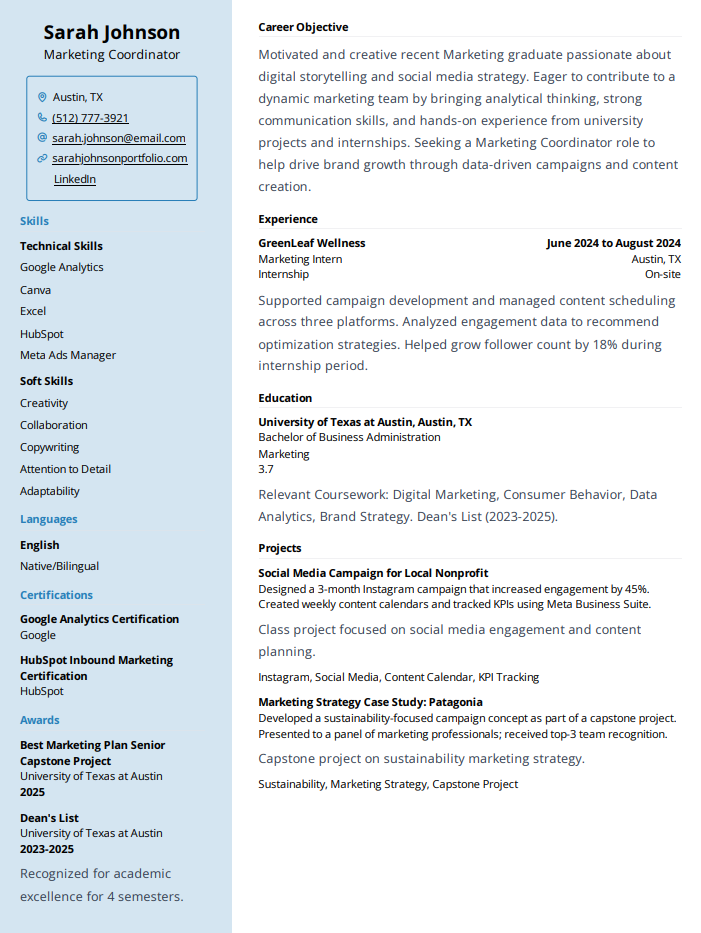
Career Changer
If you’re transitioning careers, your goal is to connect past experience to your future direction. Focus on transferable skills, recent certifications, and any freelance or self-directed projects that show you’re serious about the change.
👉 Example: “Completed Google UX Design Certificate and redesigned a nonprofit website to improve engagement by 35%.”
You can browse Democruit’s editable resume samples for each type - all structured to highlight your strengths, even without traditional experience.
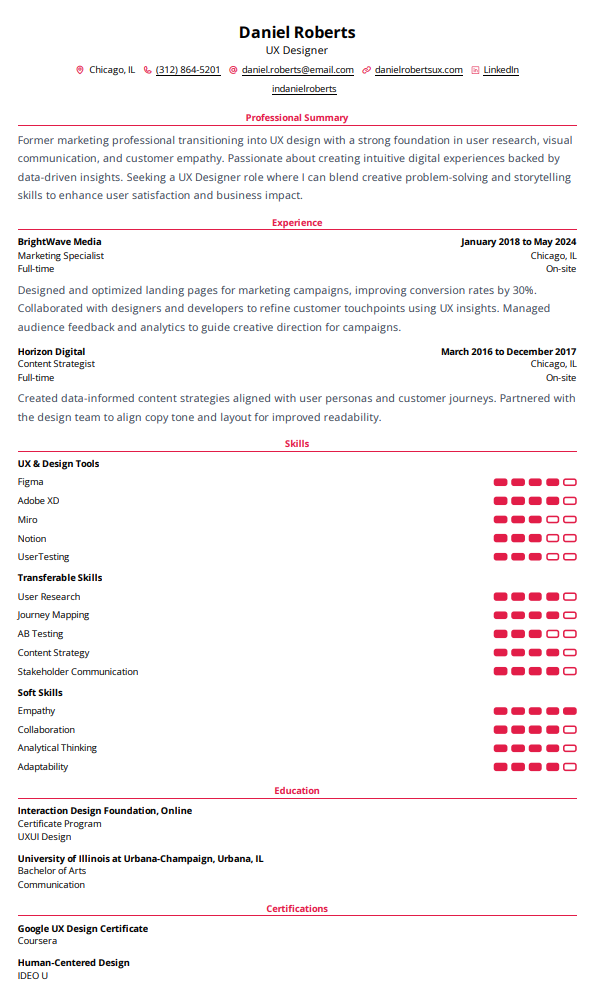
Pair Your Resume With a Cover Letter
When you have little or no work experience, your cover letter becomes your voice - the space where you explain your story, motivation, and potential. While your resume lists facts, your cover letter connects them into a narrative that helps employers see why you’re a great fit.
Use it to show enthusiasm, clarity, and purpose. Briefly explain why you’re interested in the role, what you can contribute, and how your background (education, projects, or skills) aligns with the company’s goals. Keep it personal but professional, and match the tone and keywords of your resume so both documents feel consistent and cohesive. Want to make your cover letter stand out too? Learn how to use AI tools to craft personalized letters that impress recruiters - check out our full guide on AI cover letter generators.
Here’s a quick example of how to start your letter:
“I’m excited to apply for the Marketing Assistant position at BrightWave. Although I’m a recent graduate, my coursework in digital media and my experience managing a student-run Instagram account have given me hands-on skills in content creation and analytics - which I’m eager to bring to your team.”
A thoughtful cover letter can turn a simple resume into a compelling story of growth and potential. Tools like Democruit can help you generate personalized cover letters that align with your resume’s tone and role - so every application feels authentic and job-ready. Explore Democruit’s free cover letter templates designed for students, graduates, and career changers - each one optimized to match your resume and help you make a great first impression.
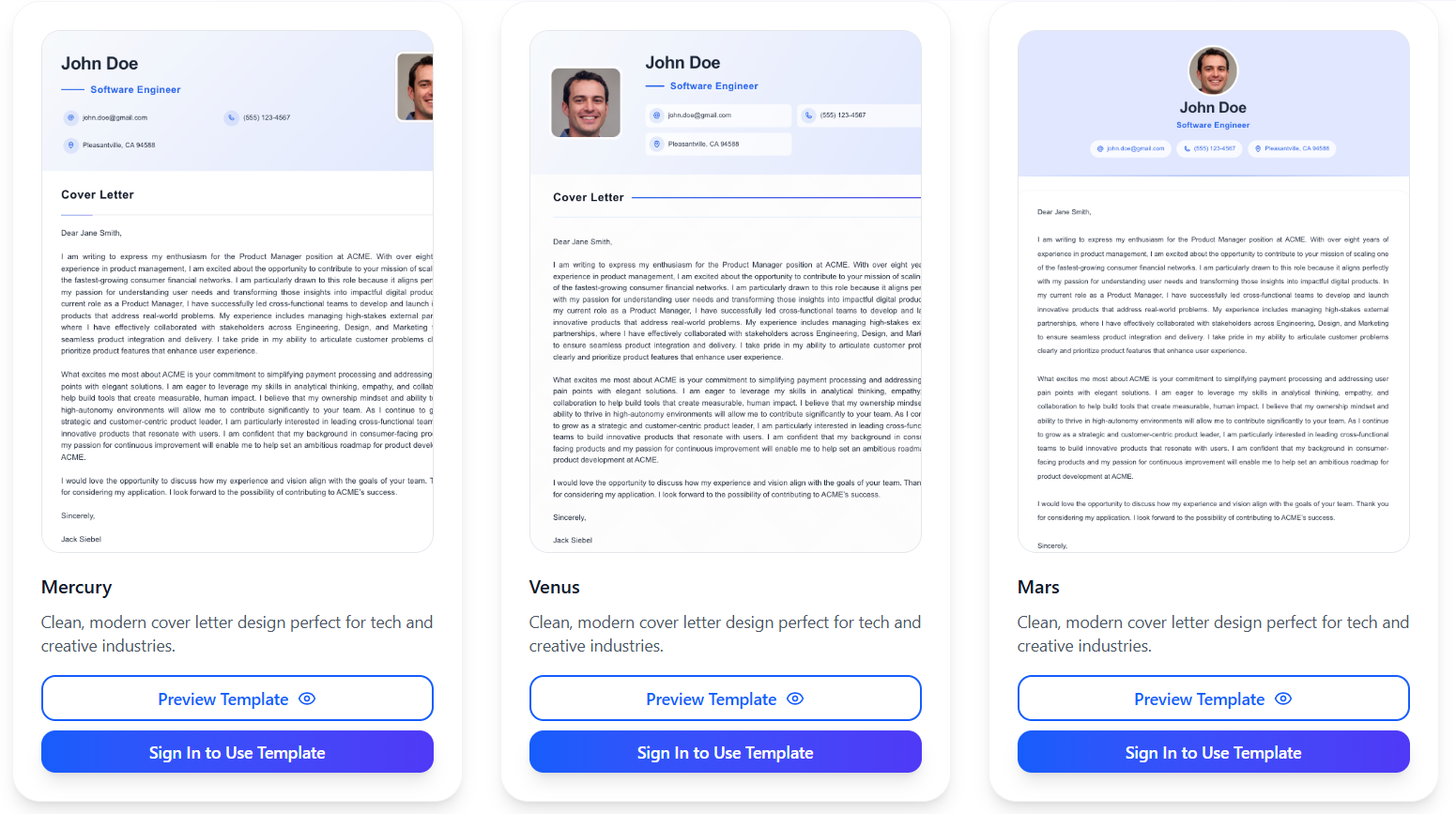
Key Takeaways
Writing your first resume may feel daunting, but now you know exactly how to write a resume with no experience - and make it stand out. The key is mindset: instead of focusing on what you lack, highlight what you offer - your motivation, transferable skills, and eagerness to learn.
Structure your resume with intention: use a clear format, strong action verbs, and sections that showcase your value - like projects, coursework, or volunteer work. Optimize it for recruiters and Applicant Tracking Systems (ATS) by aligning your resume and cover letter with relevant keywords from the job description. For more practical advice on improving your resume and avoiding common mistakes, check out our guide on resume tips.
Remember, even if you’re writing a resume for your first job or as a college or high school student, every experience counts when framed strategically.
And if you want a head start, tools like Democruit help you create ATS-friendly resumes and cover letters that reflect your story - even without formal experience. Your initiative and authenticity matter more than any job title.
FAQs
1. How do I make my resume stand out if I’ve never had a job before?
Focus on achievements from school, volunteering, personal projects, or extracurriculars. Use action verbs and quantify results where possible.
2. Can I list non-paid or freelance work as experience?
Yes. Any experience where you’ve demonstrated skills - even unpaid - counts. Label it clearly (e.g., “Freelance Web Developer” or “Volunteer Research Assistant”).
3. Should I include hobbies or personal interests on my resume?
If they show relevant skills or character traits (like leadership, teamwork, or creativity), absolutely. Just keep them professional and concise.
4. How long should a resume with no experience be?
One page is ideal. Focus on quality, not quantity - choose details that directly support your career goals.
5. What’s better for beginners: a resume objective or a summary?
A short, well-written objective works better when you have limited experience. Use it to show your motivation and what you’re aiming for.
6. How can I make my resume look professional without design software?
Use a clean, ATS-friendly template in Word or Google Docs. Stick to one font, clear headings, and consistent spacing.
7. Do school projects really matter on a resume?
Yes - especially if they show problem-solving, teamwork, or technical skills relevant to the job. Treat major projects like mini work experiences.
8. Should I mention my GPA or not?
Include it if it’s strong (generally above 3.5/4.0) or if you’re a recent graduate. Otherwise, focus on coursework or achievements instead.
9. What if I have no degree - can I still build a good resume?
Definitely. Emphasize certifications, online courses, practical skills, and projects that demonstrate your ability to perform in the role.
10. How can I talk about my “no experience” resume in an interview?
Focus on what you’ve learned through education, volunteering, or personal work - and link those lessons to what the company needs.
